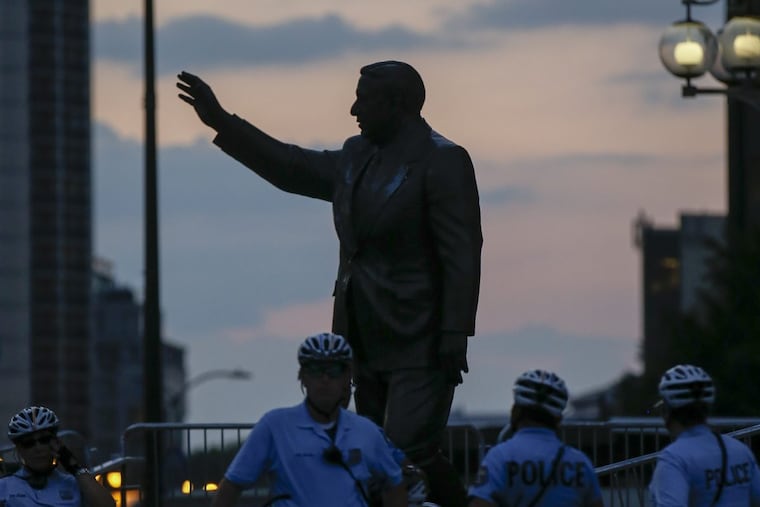Reader Poll: Most want Rizzo statue moved, but where?
In total, nearly 60 percent of voters opted to keep Rizzo in a place of honor. Another 35.5 percent voted to demote, recontextualize, or dispose of the statue entirely.

From the more than 1,000 responses to our reader poll, there seems to be broad agreement that the statue of Frank L. Rizzo could find a more appropriate home. But that's where the agreement ends.
The largest share of voters — 28.8 percent — favored moving the 2,000-pound bronze statue to North Broad Street, in front of the building that once housed the Philadelphia Inquirer and Daily News, and which will soon be the new headquarters of the Philadelphia Police Department. The spot is apropos for a former police commissioner and law-and-order mayor, and it would cut down on the department's costs, as officers have been tasked with either guarding the statue or investigating vandals who target it. It would take nerves of bronze to egg a statue at the front door of Police Headquarters.
In total, nearly 60 percent of voters opted to keep Rizzo in a place of honor — either leaving him where he is now, across from City Hall (12.8 percent), moving him to the new headquarters (28.8 percent), or sending him back to his South Philly roots (18.1 percent).
Also, 35.5 percent voted to demote, recontextualize, or dispose of the statue entirely. Moving Rizzo to a museum — where the man's accomplishments, flaws, and motivations could be placed in historical and educational context — was the second-most-popular option, garnering 25.3 percent of the vote. Nearly 6 percent opted for a category we call "Storage or Worse," with suggestions ranging from the cliche, "td {border: 1px solid #ccc;}br {mso-data-placement:same-cell;}at the bottom of the Schuylkill to swim with the fishes," to the constructive: "Melt it down and re-purpose it for something relative to the civil rights cause."
Other write-in votes also provided some interesting ideas, and as always, many impassioned feelings.
What started this conversation?
Some critics and officials have called for a discussion of removing the giant Rizzo statue from Center City, in the wake of racial tensions after a white supremacist rally in Charlottesville.
Other cities are grappling with similar questions, although mostly relating to Confederate-era figures, not political figures from the 1970s. In Raleigh, N.C., protesters toppled a Confederate memorial, and some were arrested. In Baltimore, the mayor and City Council preempted protests by having four Confederate statues taken down in the middle of the night. In Dearborn, Mich., a statue of Orville Hubbard, the segregationist mayor from 1942 to 1978, has already been moved. Twice, in fact, just in the last year.
The Rizzo statue, standing 10 feet 4 inches tall and weighing about 2,000 pounds, is too heavy and too bottom-heavy to topple, one engineer said. It was commissioned by the Frank L. Rizzo Monument Committee, was unveiled on the steps of the Municipal Services Building in 1999 and thereafter was donated to the City of Philadelphia.
So we asked our readers: If Philadelphia officials decide to move the Rizzo statue to another site away from City Hall, where do you think they should put it?
It's worth noting that this poll was premised on if the statue were to move, where should it go. So leaving the statue in place was not one of the five options in the poll, nor was destroying it. But for both of those categories, we got plenty of people writing in those answers.
Of course, the city hasn't been ready to move the the statue previously and there's no guarantee there will be consensus to do so now. We can be certain, however, that any decision will be contentious. In the meantime, police can keep an eye out on Big Frank in case protesters keep egging the statue and spray-painting it, and both sides can keep circulating petitions until the next major incident erupts.
Rizzo statue fast facts:
Sculptor: Zenos Frudakis
Material: Bronze
Height: 10 feet, 4 inches
Weight: Approximately 2,000 pounds, per Billy Penn
Unveiled: Jan. 1, 1999
Commissioned by: The Frank L. Rizzo Monument Committee, donated to the City of Philadelphia